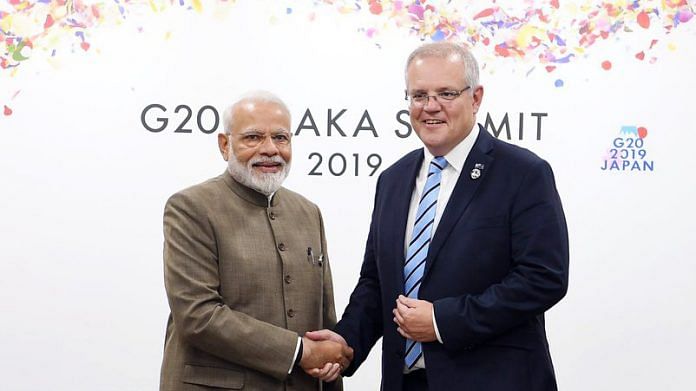The virtual bilateral summit between Prime Minister Narendra Modi and his Australian counterpart Scott Morrison Wednesday is a big deal. Not just because it is perhaps the first virtual summit of its kind, nor because it demonstrates the determination to ‘meet’ despite the international travel restrictions. It is important because it takes place at a time when both countries find themselves under attack from the belligerent dragon — China.
A common threat
For India, the ‘Wuhan spirit’ or the bonhomie after the informal summit between President Xi Jinping and PM Modi in 2018 has been wiped out by the virus from Wuhan, along with China’s ongoing aggression in Ladakh.
For Australia, its thriving economic relationship with China has been hit by sanctions on beef and barley exports — ostensibly a retaliation to Canberra having had the temerity to ask for an independent inquiry into the origins of the novel coronavirus. Morrison responded to Chinese bluster and bullying by replying firmly that Australia won’t trade away its values.
For Prime Minister Morrison, standing up to China is becoming familiar territory. As treasury secretary in 2015, he had to strengthen his country’s foreign investment review process after the Northern Territories government signed a 99-year lease agreement for the strategic port of Darwin with a Chinese company that has links with the People‘s Liberation Army. He then had to invoke the new provisions twice in 2016 — to block the sale of Australia’s largest cattle business, S Kidman’s 100,000 square kilometres of land holdings to a Chinese consortium, and to prevent a state-owned Chinese company from buying a controlling stake in power distribution company Ausgrid, which also manages critical communications infrastructure. Later, as the home minister, he had to invoke national security provisions to keep Huawei out of Australia’s 5G infrastructure.
Over the last few years, China’s influence on operations in Australia have grown to a point where the country feels that its institutions and its values are under a coordinated and relentless attack. Chinese-Australian tycoons have attempted to bribe gullible politicians; Chinese community leaders are mobilised to rally support for Beijing’s position on the South China Sea; Chinese students on university campuses have clashed with others over developments in Hong Kong; cyber security attacks have targeted Australian research institutions and even parliament. The list is endless.
In response, Australia has had to shore up its defences by crafting a series of administrative and legislative provisions aimed at protecting its political system, its university campuses, its critical infrastructure. These hold important lessons for other countries that seek to protect their open economy and democratic polity against the predatory attacks of a power that plays by a different set of rules.
Also read: China considers more economic pain for Australia amid bitter spat over coronavirus origin
India-Australia bilateral agenda
But there is also an ambitious bilateral agenda that will add substance to the India-Australia summit. Media attention will undoubtedly focus on the signing of a Logistics Support Agreement that adds some muscle to the US-India-Japan-Australia Quad. The AusIndex naval exercises and the annual 2+2 meetings bringing together the Defence and Foreign Secretaries also contribute to the growing security dimension of the relationship between the two countries.
However, it is the economic dimension that continues to lag. The summit provides Modi and Morrison with the opportunity to impart a fresh momentum to it. Bilateral trade is barely $30 billion and even though Australia is a world leader in niche technologies, investment in India is relatively limited. The report ‘An India Economic Strategy to 2035’ by Peter Varghese, former Australian Foreign Secretary and High Commissioner to India, provides an excellent blueprint. It identifies 10 states and 10 sectors of the economy that can be of particular focus, and underscores the important role of investment in driving the economic relationship. But while Canberra sees the opportunity, private business groups have been shy to grab it. With the exception of the Macquarie Group and a couple of others, Australia’s large financial institutions, pension funds and even the sovereign Future Fund have shown reluctance to invest in India. From India, the Adani group’s multi-billion dollar investment into the Carmichael coal fields in Queensland also ran into a series of hurdles and dampened some of the initial ardour to invest in Australia.
There are also a number of less glamorous areas that offer fertile ground for collaboration in sectors where Australia has proven expertise. Some projects are already underway in agriculture, animal husbandry, water conservation, mining technology and equipment and sports infrastructure, but there is ample scope for scaling these to become success stories that both countries can proudly showcase. Cyber security is of critical interest to both, as is the need to work together in tapping Australia’s huge deposits of lithium and rare earths.
However, none of this is new and much of this has been discussed in previous high-level engagements. China might just be the catalyst that was needed to infuse new energy into a relationship that has always basked in its potential, but never managed to realise it.
The author is currently a Distinguished Fellow at ORF and has served as India’s High Commissioner to Australia. Views are personal.
Also read: Australia vows to cement Quad with India, US, Japan as ‘anti-China’ group gets new life




All this may be very well, but with a per capita income of $ 6 a day we need to ask ourselves whether at this stage of economic development, it would not be more sensible to build up our strengths and bide our time.
There advantage for both India & Australia both Democratic countries to work in all fields to gain advantage after what China has done.Indian companies have invested heavily in developing minerals and coal.